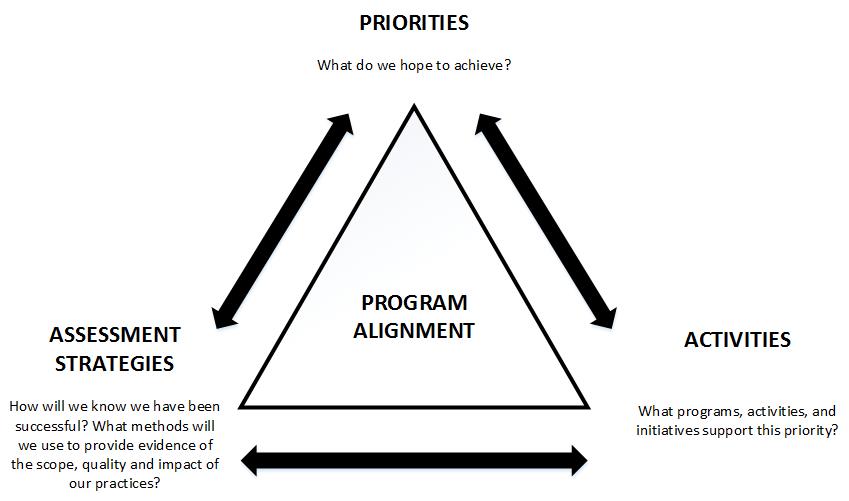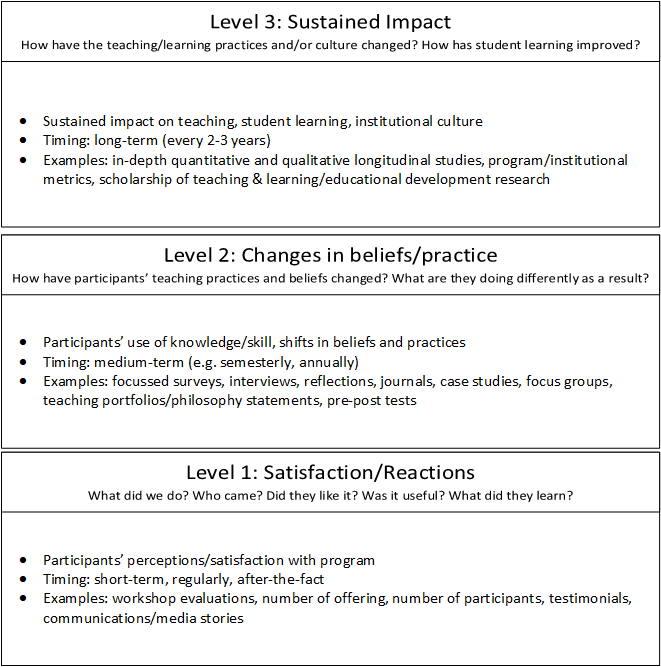The portfolio approach
A portfolio approach recognizes the inherent breadth, depth and richness of the approaches we take to support teaching and learning in post-secondary education (Wright and Miller, 2001). Foundational to this approach are:
- underlying principles, values, philosophies, and beliefs that guide our everday practices, activities and approaches
- processes, goals, and activites that we engage in, and that support and align with our core principles and beliefs.
- artefacts that provide tangible evidence of the scope, impact, and quality of our activities and approaches (see Figure 1).

This approach also recognizes that in order to have sustained impact, strategic planning processes should be flexible and responsive to the evolving and dynamic nature of change. Therefore, it must be informed by ongoing-dialogue, reflection and a plan for assessment that informs why, how and what we do in our everyday practice, with a clear focus on continuous improvement.

A portfolio approach is grounded in a clear plan for assessment which asks: What do we want to achieve? What programs, activities, and initiatives support our priorities? What methods will we use to provide evidence of the scope, quality, and impact of our practices (see Figure 2). The assessment plan should be intentional, systematic, sustainable, goal-oriented, and based on multiple measures and strategies which provide both summative and formative forms of evaluation (Hines, 2009; Kreber et al., 2001). As Kreber et al. (2001) suggest, this approach promotes meaningful alignment between the nature of the activity, its intended impact, and the strategies for evaluation (Figure 3).

Chalmers and Di Gardiner (2015) argue we must think beyond participant outcomes and satisfaction, focusing rather on the intended outcomes of our programs. They call for a systematic approach to gathering relevant and varied quantitative and qualitative data over the short and long term in order to provide a comprehensive approach to provide evidence of the impact of our programs. A portfolio approach encourages alignment of individual programs and activities to the larger whole by asking questions such as:
- What program or activity would we most like to assess?
- What larger unit priority or goal does this activity best align with?
- What specific outcomes do we hope to achieve through this activity? What questions do we currently have about this program that we would like to answer?
- What artefacts (e.g. documentation or materials) best provide evidence of the scope of this activity?
- What assessment methods would help us answer the questions we have and/or would provide evidence of the quality and impact of this program?
- How often will we use this assessment method to evaluate this program or activity?
References:
Biggs, J. 1996. Enhancing teaching through constructive alignment.” Higher education 32, 347-364.
Biggs, J. 2014. Constructive alignment in university teaching. HERDSA Review of Higher Education 1, 5-22.
Chalmers, D., and Gardiner, D. 2015. An evaluation framework for identifying effectiveness and impact of academic teacher development programmes. Studies in Educational Evaluation 46, 81-91.
Grabrove, V., Kustra, E., Lopes, V., Potter, M.K., Wiggers, R., & Woodhouse, R. 2012. Teaching and Learning Centres: Their Evolving Role Within Ontario Colleges and Universities. Toronto: Higher Education Quality Council of Ontario.
Hines, S. R. 2009. Investigating faculty development program assessment practices: what’s being done and how can it be improved. Journal of Faculty Development 23(3), 5-19.
Kirkpatrick, D.L. and Kirkpatrick, J.D. 2006. Evaluating Training Programs: The Four Levels (3rd Edition). Berrett-Koehler Publishers.
Kreber, C., Brook, P. and E. Policy. 2001. Impact evaluation of educational development programmes, International Journal for Academic Development 6(2), 96-108.
Wright, W. A., & E Miller, J. (2000). The educational developer’s portfolio. International Journal for Academic Development, 5(1), 20-29.